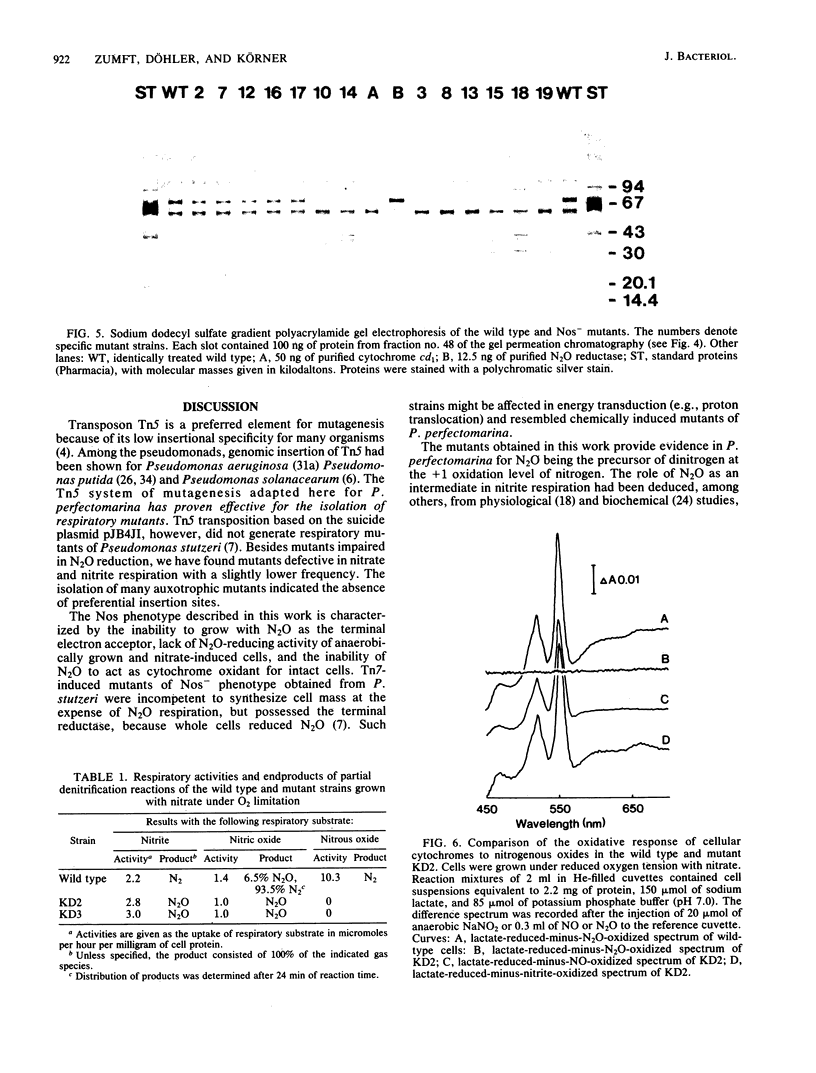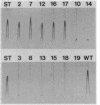Abstract
Transposon (Tn5) mutagenesis of Pseudomonas perfectomarina with the plasmid pSUP2021 [(pBR325-Mob(RP4))::Tn5] and the chromosomally integrated RP4 plasmid in Escherichia coli as the donor, produced three distinct groups of mutants that were defective in nitrous oxide respiration. One group of mutants lacked the structural protein of N2O reductase, the second synthesized a copper-free apoprotein; and a third group expressed a low level of intact enzyme. The mutants provided evidence for N2O being the immediate precursor of dinitrogen in denitrification and documented the essentiality of the copper enzyme. Synthesis of N2O reductase depended strongly on the growth conditions, with N2O-grown cells expressing the lowest level of enzyme. Regulatory responses of mutants elicited by nitrate or oxygen were unaltered when compared with wild-type behavior.
Full text
PDF






Images in this article
Selected References
These references are in PubMed. This may not be the complete list of references from this article.
- Balderston W. L., Sherr B., Payne W. J. Blockage by acetylene of nitrous oxide reduction in Pseudomonas perfectomarinus. Appl Environ Microbiol. 1976 Apr;31(4):504–508. doi: 10.1128/aem.31.4.504-508.1976. [DOI] [PMC free article] [PubMed] [Google Scholar]
- Boogerd F. C., van Verseveld H. W., Stouthamer A. H. Electron transport to nitrous oxide in Paracoccus denitrificans. FEBS Lett. 1980 May 5;113(2):279–284. doi: 10.1016/0014-5793(80)80609-0. [DOI] [PubMed] [Google Scholar]
- Carlson C. A. The physiological genetics of denitrifying bacteria. Antonie Van Leeuwenhoek. 1982;48(6):555–567. doi: 10.1007/BF00399541. [DOI] [PubMed] [Google Scholar]
- Greenberg E. P., Becker G. E. Nitrous oxide as end product of denitrification by strains of fluorescent pseudomonads. Can J Microbiol. 1977 Jul;23(7):903–907. doi: 10.1139/m77-133. [DOI] [PubMed] [Google Scholar]
- Görg A., Postel W., Westermeier R., Gianazza E., Righetti P. G. Gel gradient electrophoresis, isoelectric focusing and two-dimensional techniques in horizontal, ultrathin polyacrylamide layers. J Biochem Biophys Methods. 1980 Nov;3(5):273–284. doi: 10.1016/0165-022x(80)90008-1. [DOI] [PubMed] [Google Scholar]
- Jeter R. M., Sias S. R., Ingraham J. L. Chromosomal location and function of genes affecting Pseudomonas aeruginosa nitrate assimilation. J Bacteriol. 1984 Feb;157(2):673–677. doi: 10.1128/jb.157.2.673-677.1984. [DOI] [PMC free article] [PubMed] [Google Scholar]
- KLUYVER A. J., VERHOEVEN W. Studies on true dissimilatory nitrate reduction. II. The mechanism of denitrification. Antonie Van Leeuwenhoek. 1954;20(3):241–262. doi: 10.1007/BF02543727. [DOI] [PubMed] [Google Scholar]
- LOWRY O. H., ROSEBROUGH N. J., FARR A. L., RANDALL R. J. Protein measurement with the Folin phenol reagent. J Biol Chem. 1951 Nov;193(1):265–275. [PubMed] [Google Scholar]
- Marshall T., Williams K. M. Artifacts associated with 2-mercaptoethanol upon high resolution two-dimensional electrophoresis. Anal Biochem. 1984 Jun;139(2):502–505. doi: 10.1016/0003-2697(84)90041-1. [DOI] [PubMed] [Google Scholar]
- Matsubara T., Frunzke K., Zumft W. G. Modulation by copper of the products of nitrite respiration in Pseudomonas perfectomarinus. J Bacteriol. 1982 Mar;149(3):816–823. doi: 10.1128/jb.149.3.816-823.1982. [DOI] [PMC free article] [PubMed] [Google Scholar]
- Matsubara T., Iwasaki H. Enzymatic steps of dissimilatory nitrite reduction in Alcaligenes faecalis. J Biochem. 1971 May;69(5):859–868. doi: 10.1093/oxfordjournals.jbchem.a129537. [DOI] [PubMed] [Google Scholar]
- Matsubara T. The participation of cytochromes in the reduction of N20 to N2 by a denitryfying bacterium. J Biochem. 1975 Mar;77(3):627–632. doi: 10.1093/oxfordjournals.jbchem.a130764. [DOI] [PubMed] [Google Scholar]
- O'Neill E. A., Kiely G. M., Bender R. A. Transposon Tn5 encodes streptomycin resistance in nonenteric bacteria. J Bacteriol. 1984 Jul;159(1):388–389. doi: 10.1128/jb.159.1.388-389.1984. [DOI] [PMC free article] [PubMed] [Google Scholar]
- Payne W. J., Grant M. A., Shapleigh J., Hoffman P. Nitrogen oxide reduction in Wolinella succinogenes and Campylobacter species. J Bacteriol. 1982 Nov;152(2):915–918. doi: 10.1128/jb.152.2.915-918.1982. [DOI] [PMC free article] [PubMed] [Google Scholar]
- St John R. T., Hollocher T. C. Nitrogen 15 tracer studies on the pathway of denitrification in Pseudomonas aeruginosa. J Biol Chem. 1977 Jan 10;252(1):212–218. [PubMed] [Google Scholar]
- Stapleton M. J., Jagger K. S., Warren R. L. Transposon mutagenesis of Pseudomonas aeruginosa exoprotease genes. J Bacteriol. 1984 Jan;157(1):7–12. doi: 10.1128/jb.157.1.7-12.1984. [DOI] [PMC free article] [PubMed] [Google Scholar]
- Weeke B. Crossed immunoelectrophoresis. Scand J Immunol Suppl. 1973;1:47–56. doi: 10.1111/j.1365-3083.1973.tb03778.x. [DOI] [PubMed] [Google Scholar]
- Yen K. M., Gunsalus I. C. Plasmid gene organization: naphthalene/salicylate oxidation. Proc Natl Acad Sci U S A. 1982 Feb;79(3):874–878. doi: 10.1073/pnas.79.3.874. [DOI] [PMC free article] [PubMed] [Google Scholar]
- Yoshinari T., Knowles R. Acetylene inhibition of nitrous oxide reduction by denitrifying bacteria. Biochem Biophys Res Commun. 1976 Apr 5;69(3):705–710. doi: 10.1016/0006-291x(76)90932-3. [DOI] [PubMed] [Google Scholar]
- Yoshinari T. N2O reduction by Vibrio succinogenes. Appl Environ Microbiol. 1980 Jan;39(1):81–84. doi: 10.1128/aem.39.1.81-84.1980. [DOI] [PMC free article] [PubMed] [Google Scholar]
- Zumft W. G., Sherr B. F., Payne W. J. A reappraisal of the nitric oxide-binding protein of denitrifying Pseudomonas. Biochem Biophys Res Commun. 1979 Jun 27;88(4):1230–1236. doi: 10.1016/0006-291x(79)91111-2. [DOI] [PubMed] [Google Scholar]






